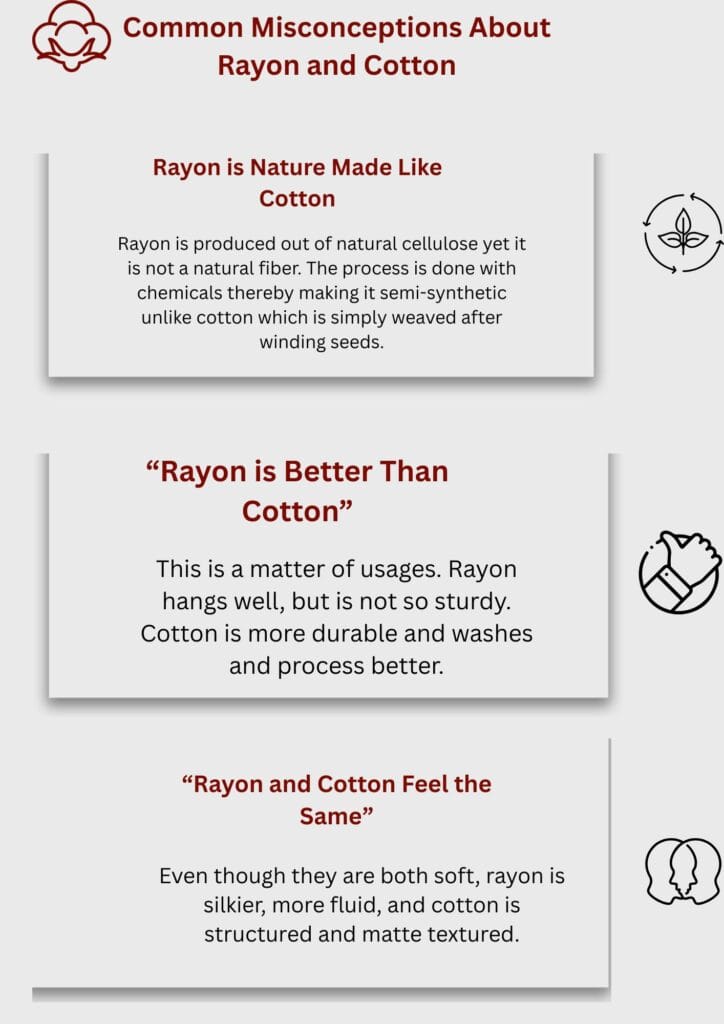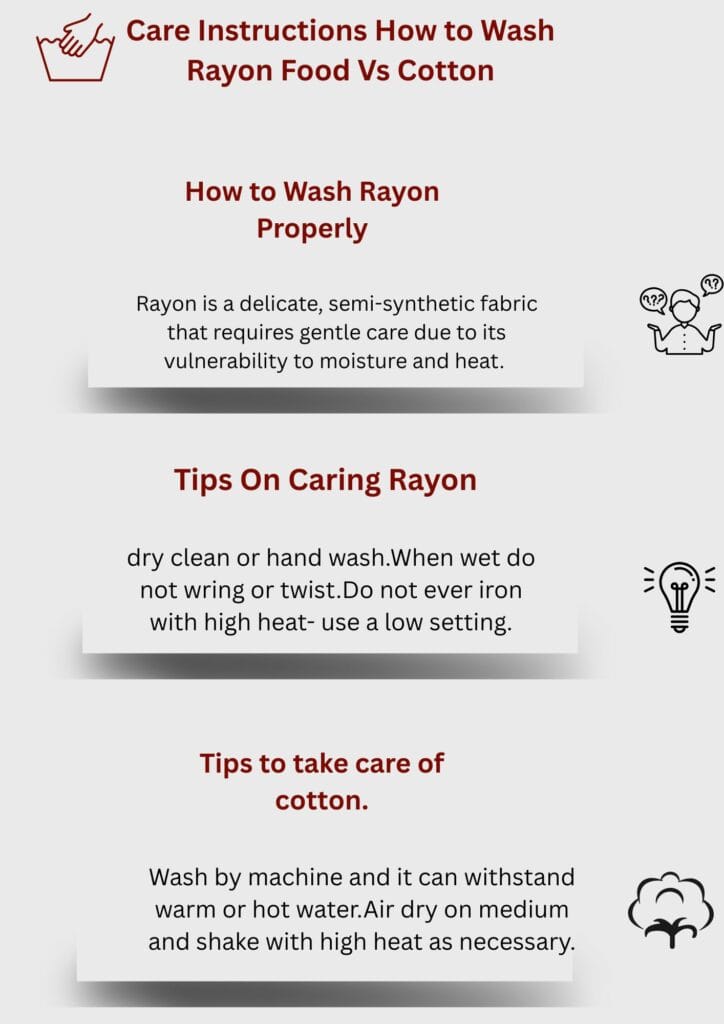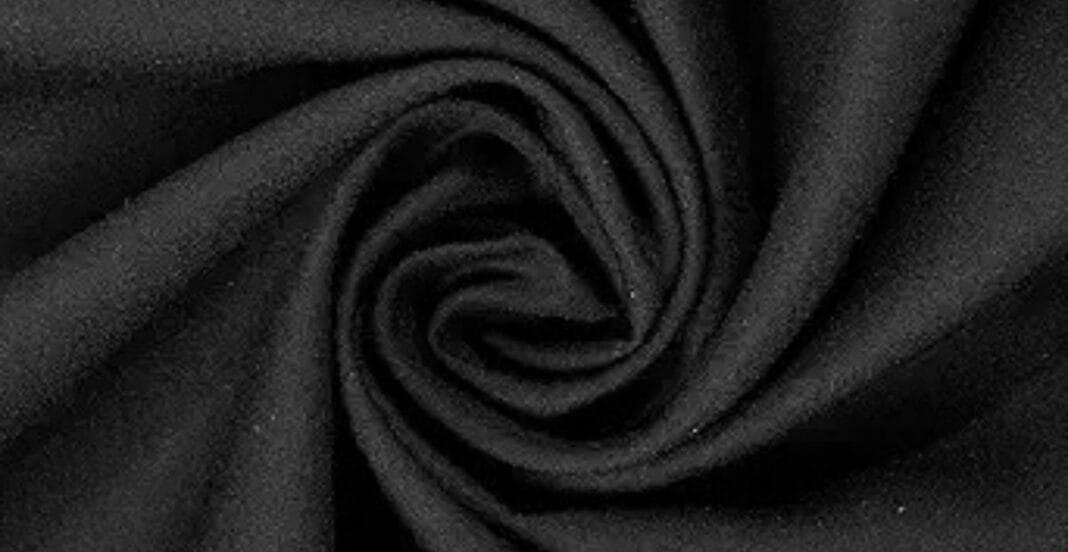Introduction
Rayon and cotton occupy prominent positions in modern garments and textiles, leading to a persistent inquiry: is rayon cotton? While both fibers may mirror one another in hand and drape, their separate origins and processing routes yield markedly different characteristics. Cotton, a wholly natural material, is harvested from the protective husks around the cotton shrub’s seeds, mechanically refined, and spun into yarn for garments, sheets, and towels. Rayon, by contrast, is designated a semi-synthetic fiber. Its principal polymer is cellulose extracted from wood pulp, yet the transformation to filament fiber demands rigorous chemical conversion, producing smooth, reflective strands.
The two fibers share a similar softness, breathability, and general comfort, inviting direct comparison. Beneath their tactile congruence, however, they diverge in critical respects: the starting material, the sequence of production steps, the durability of the finished product, and the environmental impact of the entire supply chain.
Is Rayon Cotton? – Key Differences
In summary, rayon is not cotton. The label “man made fiber from natural sources” may appear on rayon products and, while technically accurate, can create confusion; the fiber is also sold under the designations “artificial silk” and “viscose,” which further obscure its distinction from cotton.
Source: Natural vs. Semi-Synthetic
Cotton is derived entirely from the seed-hair fibers of the cotton plant, harvested with limited mechanical intervention in certified organic cultivars. Rayon, however, is classified as a semi-synthetic fiber: its original cellulose, although botanical in origin, is derived from wood pulp and subsequently subjected to a series of industrial transformations.
Production Process: Organic vs. Chemical
Cotton’s production is governed by straightforward mechanical operations—ginning, carding, spinning, and weaving—typically omitting synthetic agrochemicals in certified organic lines. Rayon’s pathway is more chemically elaborate: the wood pulp is first dissolved in a sodium hydroxide solution and subsequently treated with carbon disulfide, forming a viscous solution that is forced through spinnerets, reconstituted in a spinning bath, and finally spun into filament, thereby incorporating notable quantities of reagent chemicals.
Texture and Feel: Smooth vs. Breathable
The resulting rayon fabric presents a lustrous, smooth surface that drapes fluidly and often evokes a sense of luxury against the skin. Cotton, by contrast, offers a slightly coarser hand with a more open structure that encourages air circulation, thereby enhancing comfort in elevated-heat and humid conditions.
Durability and Strength
Cotton fibers possess high tensile strength and retain dimensional stability when wet, resisting distortion. Rayon, in contrast, is inherently weaker: exposure to moisture causes the fibers to swell and the crystalline structure to soften, substantially reducing tensile strength and rendering the fabric more prone to rupture and elongation under mechanical stress.
Rayon vs. Cotton—Pros and Cons
The comparative analysis reveals distinct benefits and limitations, clarifying the common confusion over whether rayon can be classified alongside cotton.
Pros of Rayon
- Soft & Comfortable: Rayon feels smooth and luxurious.
- Affordable: Generally cheaper than silk or high-end cotton.
- Great Drape: It falls nicely on the body, making it ideal for dresses and blouses.
- Moisture Absorbent: Rayon wicks moisture well, helping to keep you cool.
Cons of Rayon
- Weak When Wet: Rayon fibers weaken in water and may stretch or tear.
- Wrinkles Easily: It needs delicate care and often requires ironing.
- Not Machine-Friendly: Often needs hand washing or dry cleaning.
Pros of Cotton
- Weak When Wet: Rayon fibers weaken in water and may stretch or tear.
- Wrinkles Easily: It needs delicate care and often requires ironing.
- Not Machine-Friendly: Often needs hand washing or dry cleaning.
Cons of Cotton
- Weak When Wet: Rayon fibers weaken in water and may stretch or tear.
- Wrinkles Easily: It needs delicate care and often requires ironing.
- Not Machine-Friendly: Often needs hand washing or dry cleaning.
Pros of Rayon
- Cost-Effective: Typically more economical than silk or high-end cotton.
- Graceful Fall: The drape of rayon lends a flattering silhouette to blouses and soft skirts.
- Humidity-Friendly: Rayon wicks moisture, offering a measure of comfort on hot, humid days.
Cons of Rayon
- Fragile When Damp: The filament softens in water, increasing the likelihood of distortion and rupture.
- Creases Easily: Requires careful handling; most garments will require ironing after washing.
- Restrictive Cleaning: Hand wash or dry clean is usually mandated to preserve integrity.
Pros of Cotton
- Superior Ventilation: Air circulates freely, mitigating the cling of perspiration.
- Robust Construction: Stronger than rayon; strength is maintained in both dry and wet states.
- Skin-Friendly: Generally non-reactive, making it suitable for allergy-prone or sensitive skin.
- Simple Care: Machine-washable and generally forgiving of rigorous cleaning methods.
Cons of Cotton
- Shrinkage Risk: Fabrics not treated for pre-shrinkage may contract after washing.
- Creasing: Folds form less sharply than on rayon, but wrinkles remain noticeable.
- Textural Difference: The surface is more textured, lacking the slippery hand characteristic of rayon.
Common Misconceptions About Rayon and Cotton
There are still a lot of myths about these fabrics in spite of their popularity.

Rayon is Nature Made Like Cotton
Rayon is produced out of natural cellulose yet it is not a natural fiber. The process is done with chemicals thereby making it semi-synthetic unlike cotton which is simply weaved after winding seeds.
“Rayon is Better Than Cotton”
This is a matter of usages. Rayon hangs well, but is not so sturdy. Cotton is more durable and washes and process better.
“Rayon and Cotton Feel the Same”
Even though they are both soft, rayon is silkier, more fluid, and cotton is structured and matte textured.
Is Rayon or Cotton Better? The time taken (Depends on Use Case).
So does rayon cotton? None–but every cloth dazzles in different conditions.
Rayon is great in dresses, blouses and airy skirts. it is drape makes it a designer favorite.
For Clothing
Cotton is worn as casual clothes such as T-shirts, jeans and under garments.
In the case of Bedding and Towels
Cotton scores at this because it is absorbent, powerful, and strong. It is durable enough to continue being washed regularly and it is long-lasting.
For Sustainability
- Cotton that is organic is more sustainable but as long as it has been produced without using pesticides.
- The effect that rayon has is predicated by its production. More environmentally-friendly but nonetheless chemical modern eco-rayons (such as lyocell) exist.
Care Instructions How to Wash Rayon Food Vs Cotton
Care routines are helpful in the extension of the life of fabrics.

Tips On Caring Rayon
- dry clean or hand wash.
- When wet do not wring or twist
- Do not ever iron with high heat- use a low setting.
Tips to take care of cotton.
- Wash by machine and it can withstand warm or hot water.
- Air dry on medium and shake with high heat as necessary.
- Can be bleached (white cotton) but without pre-treatment they will shrink.
Environmental Impact – Is Rayon or Cotton More Sustainable?
Cottons Carbon Footprint
Cotton is renewable and also biodegradable. But it takes a great deal of water and pesticide feed in the cultivation of this crop, unless organic. It also requires plenty of land and energy.
Rayon The Environmental Footprint
Rayon is also manufactured with renewable wood pulp; however, the manufacture usually contains toxic chemicals. Certain factories even get rid of these in an unproper way, which influences the air and the water. But sustainable forms of rayon such as TENCEL (Lyocell) have closed-loop systems which are less polluting.
Blended Fabrics – Rayon-Cotton Mix (Pros & Cons)
A combination of viscose and cotton provides an ideal mixture. It is a usual habit in the industrial sector in the textile sector.
Why Brands Blend Them
A mix enhances texture, breakage and price. Cotton makes strong but rayon imparts softness and drapery. The two of them combine to produce more comfortable and wearable fabrics.
Common Uses
Rayon-cotton combinations will be in:
- Blouses and shirts
- Casual dresses
- Bed linens
- Soft T-shirts
The combination has an improved moisture absorption, breathability, and adjustable style.
Conclusion
To conclude the question, is rayon cotton? Absolutely not. Although they might look and be of the same texture, their breeding processes, maintenance and even their sustainability, differ significantly.
Select rayon in case you want something posh, fresh and fluid, particularly to wear in formals. Cotton is the more durable, comfortable, and breathable option especially when you want to use it on a regular basis and as home textile.
The selection will be dependent on what is comfortable to you, what you intend to do with it, and how you maintain it. It makes both fabrics similar, as they can be included in your wardrobe and home: once you know what each of them has to offer, you will always have the right choice to make.


